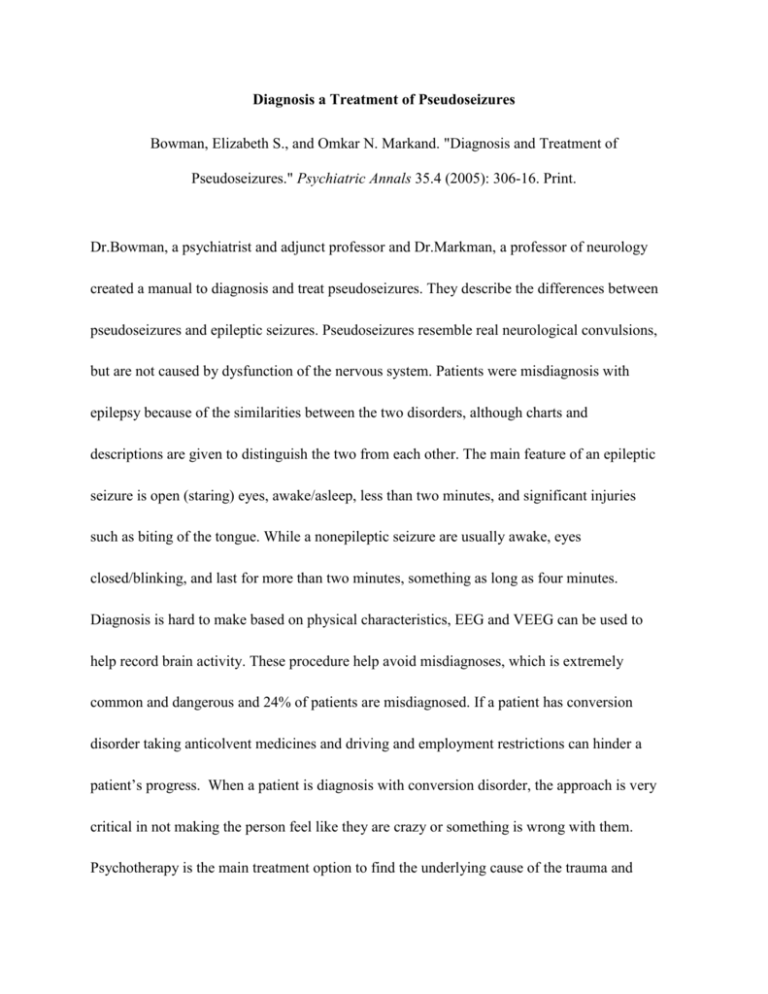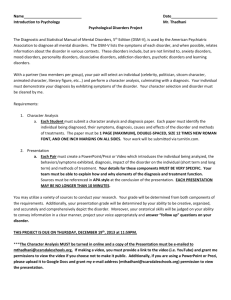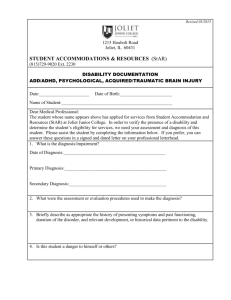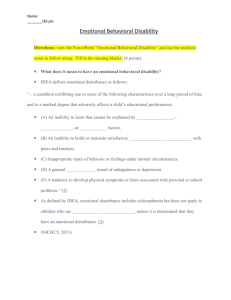Psychogenic Movement Disorders
advertisement

Diagnosis a Treatment of Pseudoseizures Bowman, Elizabeth S., and Omkar N. Markand. "Diagnosis and Treatment of Pseudoseizures." Psychiatric Annals 35.4 (2005): 306-16. Print. Dr.Bowman, a psychiatrist and adjunct professor and Dr.Markman, a professor of neurology created a manual to diagnosis and treat pseudoseizures. They describe the differences between pseudoseizures and epileptic seizures. Pseudoseizures resemble real neurological convulsions, but are not caused by dysfunction of the nervous system. Patients were misdiagnosis with epilepsy because of the similarities between the two disorders, although charts and descriptions are given to distinguish the two from each other. The main feature of an epileptic seizure is open (staring) eyes, awake/asleep, less than two minutes, and significant injuries such as biting of the tongue. While a nonepileptic seizure are usually awake, eyes closed/blinking, and last for more than two minutes, something as long as four minutes. Diagnosis is hard to make based on physical characteristics, EEG and VEEG can be used to help record brain activity. These procedure help avoid misdiagnoses, which is extremely common and dangerous and 24% of patients are misdiagnosed. If a patient has conversion disorder taking anticolvent medicines and driving and employment restrictions can hinder a patient’s progress. When a patient is diagnosis with conversion disorder, the approach is very critical in not making the person feel like they are crazy or something is wrong with them. Psychotherapy is the main treatment option to find the underlying cause of the trauma and stress that is causing the seizures. If needed medicine is needed to treat depression and anxiety it can be given to improve calm and improve the patients’ mood. Conversion disorder is treatable and manageable, with the appropriate diagnosis and treatment plan. This article was detailed in how to recognize the differences between the two seizures, how to explain it to the patient, the primary causes and treatment options. The article was written for other practicing physicians specializing in neurology and psychiatrist who do not know about conversion disorder or nonepileptic seizures. The misdiagnosis of patients is what led Bowman and Markand to write the article, a lack of knowledge on the causes and properly diagnosing of pseudoseziures. Psychogenic Movement Disorders Thomas, Madhavi, and Joseh Jankovic. "Psychogenic Movement Disorders: Diagnosis and Management." Therapy in Practice 18.7 (2004): 437-52. Print. Madhavi Thomas and Joseph Jankovic are both practicing physicians at Parkinson’s disease Center and Movement Disorders Clinic at Baylor College of Medicine. The journal was a guide to symptoms and diagnosis of psychogenic movement disorders and how they differ from neurological disorders. Thomas and Jankovic kept a record of 14,568 patients from 1988 to 2004 that visited the movement center, 530 of those patients that were sent had no “organic” cause of illness. Those 530 patients were diagnosed with a form of PMD. This journal had a case study and focused on physiological movement disorders rather than conversion disorder itself. Thomas and Jankovic stated that conversion somatoform and factitious disorders were underlying causes of a psychogenic movement disorder. Patients who experienced psychogenic tremors or shaking, which is the most common of all PMDs, 33% had conversion disorder. This is different than the other journals who look at conversion disorder alone as a reason for pseudoseizures, caused by some tragic event that occurred in their life. It did not use conversion disorder as a reason that for another psychological disorder. In addition, symptoms in helping diagnosing tremor PSM featured symptoms such as “increase with attention”. Unlike, previous journals that focused only on physical symptoms and EEG’s as the difference between actual seizures and non-epileptic seizures. Psychogenic movement disorders seem to be occurring to this journal seemed to more associate with someone who has multiple psychological disorders and that is ill, not like conversion disorders which is not always based on an underlying psychological problem. In addition, the treatment options were mostly medications, where as other journals suggested that it could be cured with therapy alone and not need to take meds. The conclusion state that PMDs are harder to diagnose into categories, compared to conversion and somatoform disorders. The article was a reliable source but did not speak much about the how to diagnosis and treatment conversion disorder. Neurological presentations of conversion disorders in a group of Singapore children Teo, Wan-yee, and Chew-Thye Choog. "Neurological Presentations of Conversion Disorders in a Group of Singapore Children." Pediatrics International. 50 (2008): 533-36. Print. This research studied children in Singapore who were children with neurological presentations of conversion disorders who were admitted to hospital. Patients were followed for 1 – 4 year. These patients experienced similar symptoms that were common to neurological disorder. This journal stated and wanted to prove that conversion disorder was not uncommon in children, this study was done in 2008. Although older journals already stated that conversion disorder happens in predominantly adolescent women, Wan-yee Teo and Chew-Thye Choong examined diagnosis in children as young as eight years old with the median age being around twelve years old. One patient was a 10-year-old boy and was diagnosed with OCD, which his grandfather had. This follows the typical diagnosis of another psychological disorder causing the seizures, but his maternal uncle had epilepsy. In the study 85% were diagnosed with conversion disorder, changing the belief that it rarely affects younger children. This journal was shorter than most of the journals and did not include much detail about the updates on the children. The journal did conclude that children can have conversion disorder and suffer from mental illnesses. This article is reliable in helping diagnosis and treat conversion disorder. Pediatric Case Study and Review: Is It a Conversion Disorder?" Spratt, Eve G., and Stephanie G. Thomas. "Pediatric Case Study and Review: Is It a Conversion Disorder?" The International Journal of Psychiatry in Medicine 38.2 (2008): 185-93. Print.









